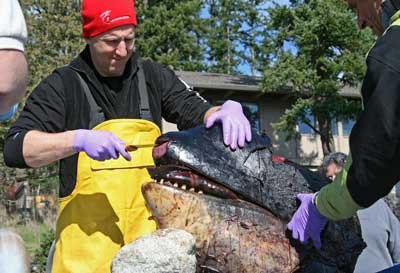With a body of evidence still under scrutiny, local biologists remain guarded about whether the recent death of a 3-year-old killer whale is the result of unnatural causes.
But some local killer whale experts are drawing their own conclusions.
“It didn’t die of disease or starvation,” Ken Balcomb of the Center for Whale Research said of the young female killer whale, known as L112 at the center. “Clearly the animal was blown up.”
Balcomb, director of the San Juan Island-based killer whale research center, contends that the signs of trauma on the body and on the head and, more importantly, among the tissues in the rear of the killer whale’s jaw are strikingly similar to the injuries that he witnessed in a group of stranded beaked whales several years ago in the Bahamas. He said those whales stranded themselves on a beach shortly after a military ship traveling in the same vicinity passed by with its sonar engaged.
“Basically it’s what happens when you blow up the head of a whale,” Balcomb said of L112 injuries.
The body of L112, also known as “Sooke” was found on a beach just north of Long Beach, Wash., on Feb. 11. Its body was battered, bloodied and bruised, and biologists estimate it had been dead several days at the most. Sooke was a member of the Southern resident killer whales, which make their seasonal home in the San Juans and were declared endanagered under federal law in 2005.
According to Amy Traxler, coordinator of the San Juan County Marine Mammal Stranding Network, its injuries appeared inconsistent with those expected if the young female had been attacked by more powerful, predatory killer whales, and that its that the injuries also are mostly inconsistent with those that occur when a killer whale, or a marine mammal, is fatally struck by a ship.
A team of biologists performed a necropsy on the carcass of the killer whale immediately after it was discovered on the beach. Tissues samples were taken and its head removed so that a CT scan could be conducted later on its skull.
The National Marine Fisheries Service, the federal agency in charge of recovery of the endangered population of killer whales, turned over the body and the head of L112 to the Whale Museum in Friday Harbor, also home to the local marine mammal stranding network. The museum intends to create an educational exhibit featuring its skeleton.
Trauma runs deep
On March 6, Dr. Joe Gaydos of SeaDoc Society and lead biologist of the stranding network, led a team of biologists as they dissected the head of L112 to collect more tissue samples and to get a closer look at the condition of the killer whale’s brain and skull. As part of that in depth examination, Gaydos said the team found no fractures of the skull or jaw, but that tissues in the rear of the jaw area show signs of trauma. He said compiling results of that in-depth examination could take several months.
“I know it’s a frustration for the public that it takes so long,” Gaydos said of the ongoing investigation into L112’s death. “On C.S.I. they can do all of this in an hour, but it can take a month or two in real life.”
According to Jason Wood, a scientist with the Sea Mammal Research Unit, an affiliate of Scotland’s St. Andrews University, the area of the jaw tissue that shows sign trauma is also the location where a killer whale draws in air to enable its echolocation, which it uses to navigate. A member of the whale museum’s board of directors, as well as the museum’s former science curator, Wood said the cause of that trauma would be difficult to pinpoint.
He did note, however, that the underwater network of hydrophones that ring the west side of San Juan Island, and that reach to Port Angles and out to Neah Bay, on the outer coast, picked up sounds of sonar about four days before L112 was found on the beach in southern Washington. He said the series of sonar pings recorded on the hydrophone network are proceeded by a series of four “explosions or implosions”, which remain undetermined and unexplained.
Sonar a suspect
Scott Viers of Beam Research, who helps to monitor the hydrophone network, said two Canadian military ships were in the area at the time the sonar was picked up on the hydrophones. One of those ships, Viers said, ventured into the Strait of Juan de Fuca while the other is believed to have remained out in open ocean, off the mouth of the strait.
Lynne Barre of the National Marine Fisheries Service said the agency hopes to collect information about activities of those Canadian ships during that time, and to include that information as part of the agency’s final report on the death of L112. At this time, however, Barre said the NMFS will wait for results of the necropsy before speculating on the cause of death.
“It’s too soon to tell,” she said.
Meanwhile, Wood said members of the Southern residents were photographed and detected on the hydrophone network 18 hours after the sonar pings were recorded. They were behaving peculiarly, and huddled in Discovery Bay, near Sequim, at that time, he said.
Balcomb has also listened to the hydrophone tapes, and said that the pings and series of explosions are strikingly familiar, adding that the U.S. and Canadian navies conduct training exercises in a federally sanctioned “bombing range” located just off the outer coast.
“I’m former Navy,” Balcomb said. “I appreciate the value of training. But you don’t have to blow up the world in the process.”




